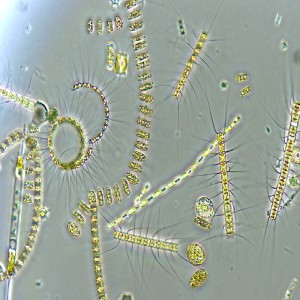Dominance of small-sized phytoplankton in a Mediterranean eutrophic coastal lagoon

Accepted: 14 April 2023
SUPPLEMENTARY PDF: 0
HTML: 42
All claims expressed in this article are solely those of the authors and do not necessarily represent those of their affiliated organizations, or those of the publisher, the editors and the reviewers. Any product that may be evaluated in this article or claim that may be made by its manufacturer is not guaranteed or endorsed by the publisher.
Authors
The predator-prey relationship is generally size-specific in the pelagic food webs. Phytoplankton cell size structure can provide information on the successive levels of consumers and therefore on the energy that can flow towards the top consumers. This work focuses on phytoplankton cell size structure in a coastal lagoon (Cabras Lagoon, Italy) considered one of the most important for fishing productivity in the Mediterranean. The inter-annual and seasonal dynamics of picophytoplankton (Pico, cell size <3 μm) and Utermöhl Fraction of Phytoplankton (UFP, cell size >3 μm) were considered during almost three years in relation to the temporal dynamics of selected environmental variables and zooplankton. Small-sized cells with a mean linear cell size <10 μm and a mean cell volume <103 μm3 mainly represented UFP along the entire study period. This size class contributed the most to total phytoplankton biomass (up to 86%) and density (up to 99%) during the first part of the investigation period. A compositional change was detected: smaller species of Chlorophyceae, Bacillariophyceae, filamentous Cyanophyceae, and autotrophic nanoflagellates thrived in the second part of the study, replacing larger Mediophyceae that dominated UFP at the beginning. Picocyanobacteria rich in phycocyanin were the dominant taxa of Pico along the entire investigation period and this size class contributed the most to total phytoplankton biomass (up to 30%) and density (up to 96%) at the end of the study. The observed shift towards different and even smaller UFP and Pico in the second part of the study was most probably due to complex interactions between top-down and bottom-up effects. Indeed, an increased temperature, a decreased salinity and decreased concentrations of nutrients (mainly ammonium and orthophosphate), as well as an increased grazing pressure of rotifers on the larger Mediophyceae were simultaneous with the changes detected in phytoplankton. The obtained results highlight a longer planktonic trophic web in Cabras Lagoon that includes small phytoplankton at the base, ciliates, rotifers, and copepods. This suggests low energy availability for planktivorous fish, with possible future relevant consequences for fishing activities in this coastal lagoon.
How to Cite

This work is licensed under a Creative Commons Attribution-NonCommercial 4.0 International License.
PAGEPress has chosen to apply the Creative Commons Attribution NonCommercial 4.0 International License (CC BY-NC 4.0) to all manuscripts to be published.


 https://doi.org/10.4081/aiol.2023.11112
https://doi.org/10.4081/aiol.2023.11112



